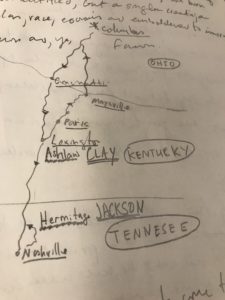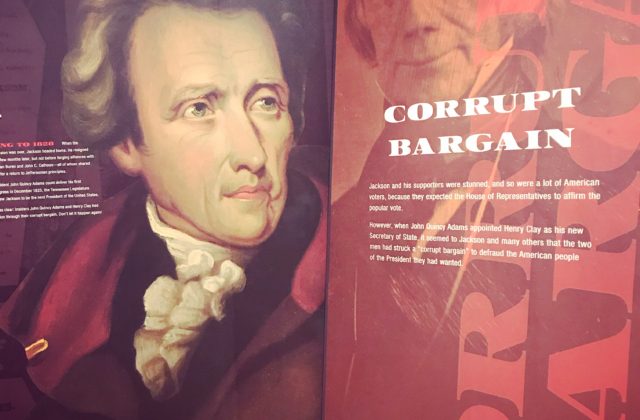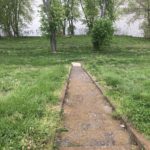An American Story: Henry Clay, Andrew Jackson and the Maysville Road
Well there’s a young man in a T-shirt
Listenin’ to a rock ‘n’ roll station
He’s got a greasy hair, greasy smile
He says: “Lord, this must be my destination”
‘Cause they told me, when I was younger
Sayin’ “Boy, you’re gonna be president”
But just like everything else, those old crazy dreams
Just kinda came and went
Pink Houses, John Mellencamp
This week I’m speaking at the Ohio Realtors legislative conference. But I arrived early to make a pilgrimage to the south to visit the homes, burial places, and museums of two giants of American history, Henry Clay and Andrew Jackson. To me they represent almost perfectly the great American dichotomy between our need for independence and individuality but at the same time our urge to pull together and have unity. The two men were opponents, and one event stands out in their decades long feud and is emblematic of the American dichotomy : the Maysville Road project.
Let us then adopt the measure before us, which will benefit all classes: the farmer, the professional man, the merchant, the manufacturer, the mechanic, and the cotton planter more than all. From Clay’s Speech in Defense of the American System.
Jackson and Clay: Jacksonian Democracy and Clay’s American System.
Andrew Jackson was born in 1767 on the border of North and South Carolina and Henry Clay was born a decade later in Virginia. While they were both southerners who came of age during the Revolution they settled in what was the American west, Clay in Kentucky and Jackson in Tennessee; it was a lush region, untamed and bristling with opportunity. It also had people already, indigenous people who would end up being decimated by removal and outright murder. Clay believed the country would benefit from what we would call today infrastructure using the tools of finance, in other words borrowed money. He was what I would call Hamiltonian. Jackson, on the other side, was more Jeffersonian, suspicious of government and especially of banks and borrowed money.
The Maysville Road
By 1830 the west was expanding. Rivers like the Ohio were being linked to inland farms and factories by canals, roads, and new harbors for barges and boats. Clay had already argued for a system of improvements he called the American System and it included protective taxes for American industries along with big government funded projects. The Maysville proposal was made after Clay had stepped down as Speaker of the House, but Jackson’s eventual veto of the road from Lexington to Maysville was not only his first veto, but also a shot at Clay’s vision. Clay was also preparing to challenge Jackson for the presidency in 1832. It would become a major campaign issue in that battle.
My Trip on US 68
I flew to Columbus, picked up a rental car and drove to Lexington to visit Ashland, a somewhat modest Italianate estate not from Downtown Lexington. Clay is buried up the road on the other side of downtown. The next day I traveled to Nashville and to Jackson’s somewhat more expansive Hermitage where Jackson is buried. I decided my trip back would include a trip up the Maysville Road built, finally, in the early 20th century.
This is the more necessary in order that they may be equitable among the several States, promote harmony between different sections of the Union and their representatives, preserve other parts of the Constitution from being undermined by the exercise of doubtful powers or the too great extension of those which are not so, and protect the whole subject against the deleterious influence of combinations.From Jackson’s veto message.
Route 68 is a much longer road, but it includes roughly the same segment proposed in 1830 and supported by Clay and vetoed by Jackson. I liked the idea of taking that drive after my visits to their museums. Perhaps I’m the first person in a long time to get satisfaction from driving on a road subject to a contentious ideological battle almost 200 years ago.
The route starts in Paris, in Bourbon county and ends in Maysville in Mason county. It is a beautiful drive with flatter country giving way to undulating hills dotted with farmhouses, cows, horses and stables and barns and hemmed in with white wood fences or stone walls. Economically, the wealth of horse breeding sand stately homes south of Paris give way to auto parts stores and defunct industrial buildings. Finally, in Maysville itself I found the most striking town, a place that had an apocalyptic feel to it. The walk up the levee on lonely stairs, and then down the other side to the Ohio was nothing less than dream like. This river, this border, fueled westward expansion with its churning depths, and marked the final natural barrier for fleeing slaves on the Underground Railroad. Now Maysville is impoverished, with about a quarter of the shrinking population below the poverty line.
Thoughts
So what does this reverie and trip have to do with housing — or anything? Well, I’m still puzzling that out. What I can say is that Hamilton and Clay won the question of finance and internal improvements. We expect and depend on investment using borrowed money and the value generated for debt service. That’s the way the world works now; except when it comes to housing. The Jeffersonian-Jacksonian principle of, “leave me alone!” has been subsidized since the end of World War II with backing and deductions for mortgages.
We’ve chosen, as a nation, to slant tax policy toward inefficient use of land with free highways, street parking, and tax breaks for mini estates, single-family homes on 5000 square foot lots. But that’s not all. Local government has decided to choke supply of new housing. This creates a “crisis” of higher prices solved by taxing new multifamily housing and jobs, and then handing that cash to inefficient, expensive, and slow construction of rent restricted units. Meanwhile, poor people face housing inflation which consumes their dollars disproportionately as prices rise.
What would Clay do? I don’t know. But his American System was based on value capture. Ours is too, but the value we’re capturing is equity for single-family home owners. Yet, we have a Jacksonian contempt and suspicion for Amazon; isn’t it all the jobs creating the problems after all?
Here’s the thing I will leave for any reader. That veto by Jackson, political, wrong headed, and aimed at Clay’s American System, killed the Maysville Road project. But I just drove down US 68 from Lexington, through Paris, and to Maysville on the Ohio. Clay’s vision won. Clay said he’d rather be right than be President. I’d rather be right than have friends or funding for supporting horrible ideas like Mandatory Inclusionary Zoning and rent control. Our vision, like Henry Clay’s, can win too. We need more housing of all kinds in all neighborhoods for people of all levels of income. But we have to be as persistent and principled as a Clay was. I just hope it doesn’t take us 100 years to get from here to there.

I’ve written on this topic and on American historical figures for years. I am a strong believer that we have to learn from history. Too often it repeats itself when it doesn’t have to. Here’s a sample.
Here I compare Jefferson and Hamilton to Cain and Abel. Guess which one is which.
Anyone who knows me knows that I despise Thomas Jefferson. I think he was mentally ill or maybe simply eccentric. The adoption of his language for the American ideal led to the Civil War and still plagues us today. While Jackson fought for the Union as did Clay, the intellectual and linguistic roots of secessionism are Jeffersonian-Jacksonian.
https://www.sightline.org/







